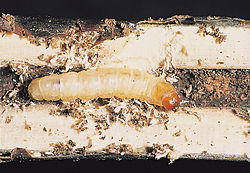| Sesiidae | |
|---|---|
 | |
| Synanthedon tipuliformis | |
| Scientific classification | |
| Domain: | Eukaryota |
| Kingdom: | Animalia |
| Phylum: | Arthropoda |
| Class: | Insecta |
| Order: | Lepidoptera |
| Superfamily: | Cossoidea |
| Family: | Sesiidae Boisduval, 1828 |
| Type species | |
| Sphinx apiformis Clerck, 1759 | |
| Subfamilies | |
| Diversity | |
| 165 genera 1,525 species | |
| Synonyms | |
| |

The Sesiidae or clearwing moths are a diurnal moth family in the order Lepidoptera known for their Batesian mimicry in both appearance and behaviour of various Hymenoptera.
Contents
The family consists of 165 genera spread over two subfamilies, containing in total 1525 species and 49 subspecies, [1] most of which occur in the tropics, though there are many species in the Holarctic region as well, including over a hundred species known to occur in Europe. [2] : Backcover, 6



